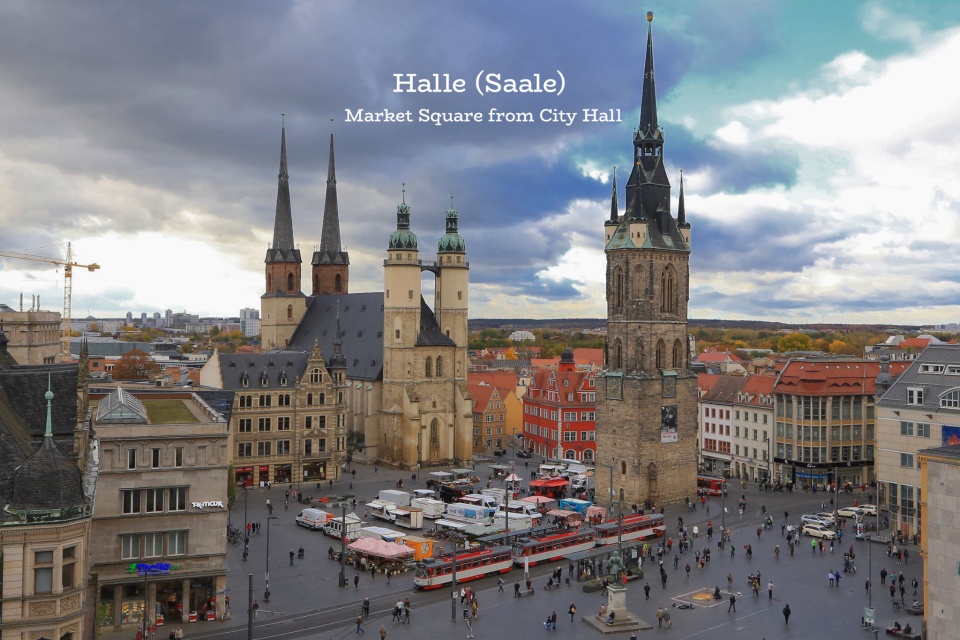Above: Playmobil Luther on top of Luther-translated Bible. (Pxhere: CC0, source tog unknown).
October 31 and Martin Luther
In most years, October 31 is a statutory holiday in five German federal states. With 2017 as a special 500th anniversary year, all 16 federal states in Germany will observe October 31 as a statutory holiday.
On 31 October 1517, the story goes that Martin Luther strode up to the front door of the Castle Church and nailed his document called “95 Theses”. Luther’s friend and colleague, Phillip Melanchthon, relayed this story years after the fact, but there’s no evidence Luther walked up to Castle Church to pin the document. What’s clear is Luther was outraged by the Catholic Church’s abuse of power and its use of indulgences as a “guilt tax” or “get-out-of-Purgatory fee” to funnel money to Rome and finance the ongoing construction of St. Peter’s Basilica (started in 1506). What’s more likely is that Luther would’ve circulated his document among trusted friends and colleagues, and would’ve quietly sent his document as a letter to his regional Church superior, Cardinal Albrecht of Brandenburg. What cannot be denied is that his document was considered a provocation, questioning the supreme authority of the Church as the sole legitimate path to God and heaven. While he might not have initially guessed the full impact of his protest document, he eventually understood that it came down to matters of control and authority, and about personal choice, especially in matters of faith.
Quick list
The 500th anniversary merely begins in 2017, as additional quincentenary dates will continue for years to come. For now, I’ve written 14 posts about Martin Luther. I describe some of Martin Luther’s history; his birth, childhood, and death; the traces he left behind; and his influence on friends, colleagues, and descendants of the Protestant movement. As interested visitor, you can reach by train most of the places in Germany. I’ve labeled UNESCO World Heritage Sites with extra ‘U’s.
- Martin Luther’s traces in 16 cities & towns throughout Germany (link)
- Augsburg: 1518 Luther vs. Cajetan Debate; The 1530 Confessions (link)
- Eisenach: Wartburg at night (link, U)
- Eisleben: Martin Luther’s birth and death sites (link, U)
- Eisleben: where Martin Luther was baptized (link)
- Erfurt: Martin Luther’s start at the Augustine Monastery (link)
- Magdeburg: City of 2 Ottos where Romanesque meets Luther (link)
- Mansfeld: Martin Luther’s childhood home (link)
- Wittenberg: 13 highlights in the Old Town (link)
- Wittenberg: Castle Church, where Luther apparently pinned his 95 Theses (link, U)
- Wittenberg: St. Mary’s Town Church, where Luther delivered his sermons (link, U)
- Weimar: Cranach Altar at the City Church (link, U)
- Worms: the world’s largest Reformation monument (link)
- The Diet of Worms in 1521: Martin Luther on trial (link)
But as I’ll also write in the near future, marking the important quincentenary is only complete with the crucial acknowledgment of his anti-Semitism, an ugly taint to his legacy and in total opposition to the message of acceptance and inclusion.
This post appears on Fotoeins Fotografie at fotoeins.com as http://wp.me/p1BIdT-aDI.
Thanks to IMG- and Sachsen-Anhalt-Tourismus who supported my visit to the German federal state of Saxony-Anhalt in 2016 with additional assistance from the cities of Eisleben, Mansfeld, Dessau, Wittenberg, and Halle (Saale); Thüringen entdecken during GTM2015; Romantic Germany (Gastlandschaften Rheinland-Pfalz) in November 2015; the city of Magdeburg in December 2015; and the city of Augsburg in March 2017.
• “Wie die Feiertage in Deutschland verteilt sind”, Berliner Morgenpost, 30.10.2017.
• “Luther’s hammer is still heard”, by Kate Connolly for Chatham House, Feb-Mar 2017.




